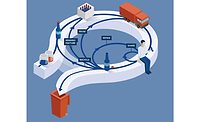Strategic Solutions
Latin America’s Quest for Innovation
Several drivers are at play for the development of new adhesive technologies in Latin America.

Figure 1. Cost differential of producing a mid-sized car for export to Europe (Mexico vs. U.S.).
Source: January 17, 2017 News, Center for Automotive Research (CAR)

Figure 2. New automotive assembly plants in Mexico ($9 billion investment).
Source: January 17, 2017 News, Center for Automotive Research (CAR)

Figure 3. Summary of USMCA automotive provisions.
Source: "Meet the New NAFTA," October 16, 2018 Feature Story, Center for Automotive Research (CAR)



In Latin America, end users in growth markets are eager for new adhesive technologies and products that improve throughput, mitigate against health and safety risks, and reduce total production costs. For suppliers bringing new adhesive products to market in Latin America, their speed to market is essential for winning new customers, as is product differentiation achieved through rapid development cycles and product launches. Success in this region, according to our sources, depends on adapting to local end-use markets.
The supply side is reportedly fragmented: flexibility in meeting customer requirements is said to be an effective equalizer for local adhesive producers competing with multinational formulators in various markets. In paper and packaging, for example, there continues to be movement on metallocene technology for frozen food, beverage, and cosmetic packaging.
Natura Brasil, a well-known local brand and self-promoted cosmetics pioneer based in six Latin American countries and in France, according to its website, achieved an innovation index of approximately 65%, calculated as the percentage of revenue from products launched in the last two years. This admirable commitment to sustainable innovation is a brand differentiator coveted by local consumers and export markets. Packaging is part of the strategic mix.
Higher value is also in demand by Tier I and II transportation suppliers in Latin America that are seeking competitive advantage. Since 2000, Mexico has gained 11% share and is the largest auto parts supplier to the U.S. market. Mexico, known as the economic gateway to Latin America, has become the seventh-largest vehicle manufacturer and the leader in Latin America. Low labor costs, coupled with Mexico’s free trade agreements, have accelerated this growth, according to the Center for Automotive Research (CAR), with tariff-free access to export markets that represent 60% of the world’s GDP (see Figure 1).
OEM companies seeking near-shore access are choosing Mexico (new automotive plants are mapped on Figure 2).
During the November 2018 G20 Leaders’ Summit in Buenos Aires, Brazil, President Donald Trump, Mexican President Enrique Peña Nieto, and Canadian Prime Minister Justin Trudeau signed a new U.S. Mexico Canada Agreement (USMCA), which, if ratified by all three legislatures, would replace the North American Free Trade Agreement (NAFTA) as the governing trade policy for the region.
The USMCA stipulates that workers who are making certain classes of vehicles be paid at least $16 per hour (see Figure 3). If ratified, automakers in Mexico may offset higher wages by increasing their prices and reducing costs in materials and automation. This may be a game changer for an industry that is seriously challenged by advanced materials, diverse component designs, and joining mixed materials and assemblies.
Innovation Yields Attractive ROI
In Latin America, innovation projects typically yield a higher return on investment (ROI) compared with incremental optimization and developing so-called “me-too” products. New market entry and a supplier’s ability to launch new products in an existing market are measured as key performance indicators (KPIs) by some adhesives R&D managers. Prioritizing new R&D ideas and projects may involve a rapid technology assessment to probe the technological gaps and the value associated with the proposed solution.
Large project pipelines managed by local scientists required a ranking framework for profitably allocating their R&D spend, with buy-in from technology, sales, marketing, supply, operations and upper management. Grading a product concept using a small set of criteria (e.g., technical feasibility, time to market, and barriers for new entrants) was adopted for prioritizing what’s in the pipeline. Unambiguous data to justify the allocation of workhours and R&D resources was the desired outcome.
The pipeline’s eventual success rate was measured and tracked using the three KPIs in every phase of development through commercialization to establish an innovation index over a two- or three-year period for measuring business performance. EBITDA margins of innovative products were on average 5-8% higher than conventional “me-too” products.
Resources for Prioritizing R&D Opportunities
Timely planning for capitalizing on emerging market trends has yielded a competitive advantage for local adhesives producers that are successfully delivering in-demand products and services. Equal access to credible Latin America market studies that inform R&D strategies was cited as the most critical planning tool for profitability. While local producers may otherwise be well-positioned to compete in the same markets, ultimately their success is dependent on access to the same market data leveraged by multinational companies as the basis for prioritizing unmet market needs and R&D initiatives.
Common scenarios involve assessing your existing technology’s fit for a new market. One respondent whose company had a presence in Mexico, Columbia, Peru and Argentina characterized this exercise as a “cross pollination” between various technologies and compatible markets. Will export markets (especially to the U.S. and Europe) broaden a local producer’s reach? In Latin America, the adhesives value chain is interconnected for FDA and REACH compliance―and thus well-positioned for growth in the food, beverage, nutraceuticals, and cosmetic packaging categories.
An emerging area for new adhesive technologies is the local building, construction and infrastructure category, which has been characterized as having higher than average growth and a fragmented supply base.
The value of protecting intellectual property (IP) wasn’t embraced or well understood by Latin American producers. That aspect of innovation was mostly associated with the U.S. In recent R&D initiatives, however, the value of IP reportedly became apparent to at least a handful of local producers. In at least one case, the learning experience was an outgrowth of an R&D alliance with a raw material supplier and equipment manufacturer. Latin America’s IP landscape is still characterized as modest by global standards; change in this particular area is slow.
Aggie Lotz is vice president of The ChemQuest Group Inc. Nei Domingues, Ph.D., is a senior research scientist based in São Paulo, Brazil. For more information, visit www.chemquest.com.
Looking for a reprint of this article?
From high-res PDFs to custom plaques, order your copy today!









